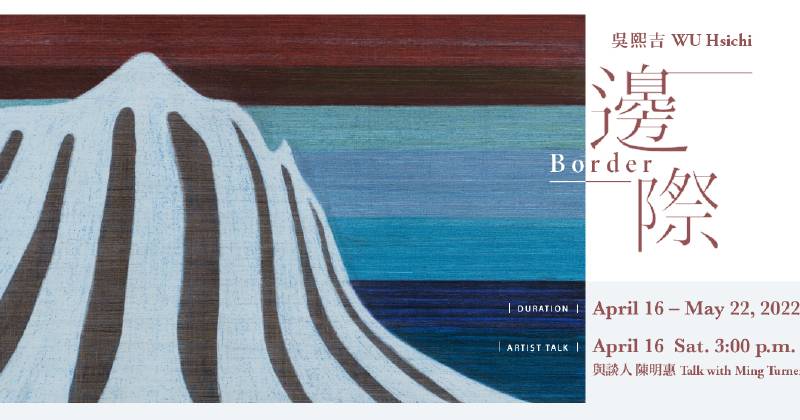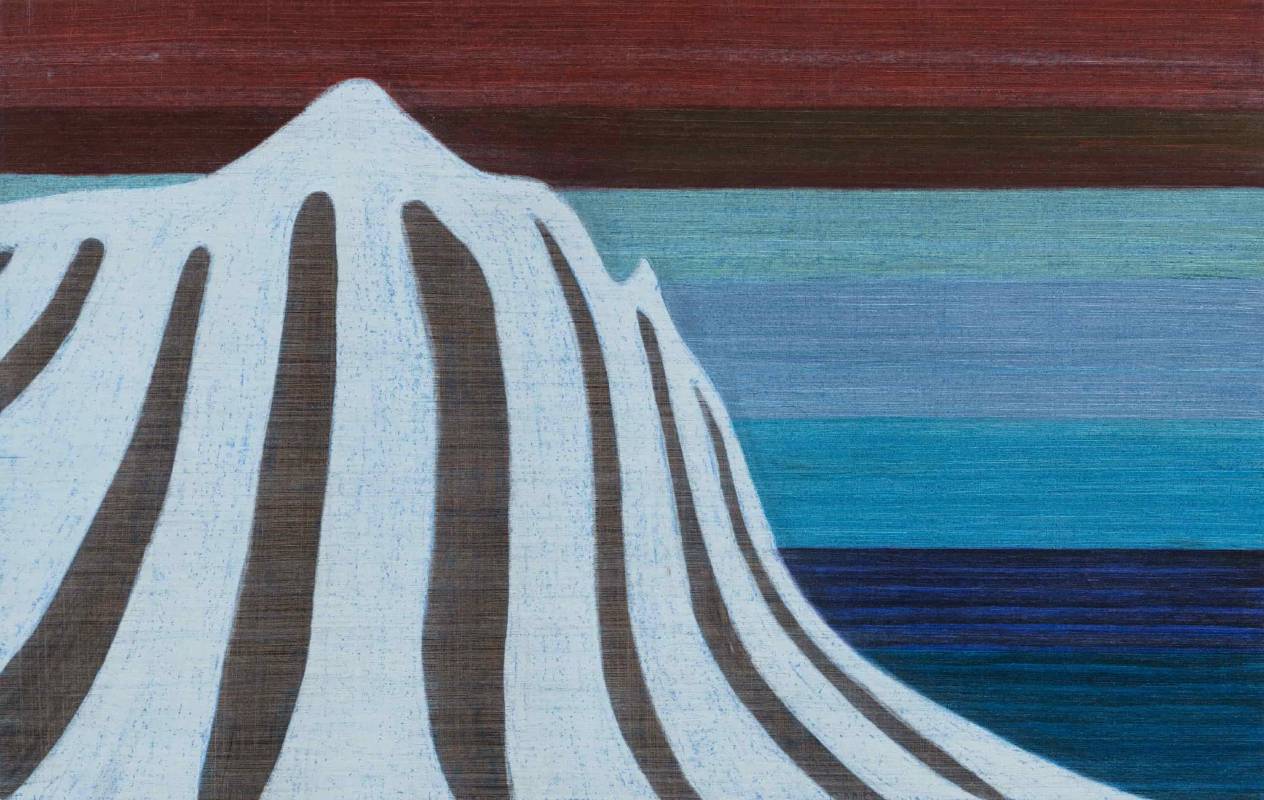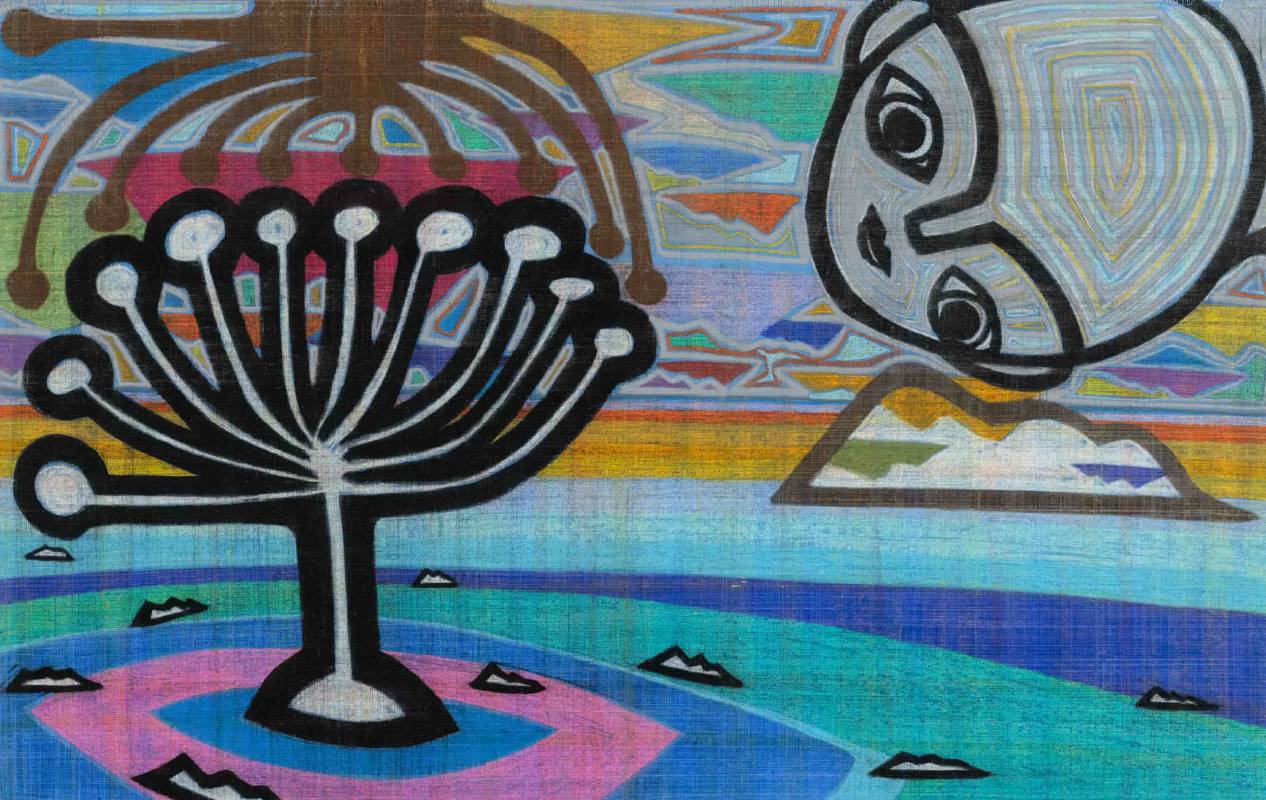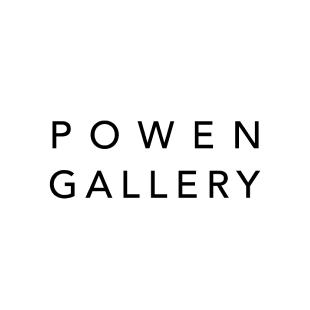紅野畫廊
【吳熙吉 : 邊際】WU Hsichi: Border

-
展期
日期:2022-04-16 ~ 2022-05-22
-
地點
台北市中山區松江路164巷11號
-
相關連結
Powen Gallery Instagram
Powen Gallery Facebook
Powen Gallery Website -
參展藝術家
吳熙吉 WU Hsichi
-
吳熙吉:邊際
WU Hsichi: Border
⋄ 藝術家 Artist | 吳熙吉 WU Hsichi
⋄ 展期 Duration | April 16 – May 22, 2022
⋄ 藝術家座談會 Artist Talk | April 16 Sat. 3:00 p.m. 與談人 陳明惠 Talk with Ming Turner
⋄ 地點 Venue | 紅野畫廊 Powen Gallery(台北市中山區松江路164巷11號,10:00-19:00 週一休館 Closed on Mondays)
⋄ 線上展間 Online Viewing Room|https://onlineviewingroom.com/exhibition/EVZT0UBACS1N/
無邊際的〈邊際〉:吳熙吉2022年個展
文 / 陳明惠
(國立成功大學創意產業設計研究所副教授 / 成大藝術中心視覺藝術總監)
2022年吳熙吉推出〈邊際〉個展,〈邊際〉展出一系列創作於2021年主要以粉彩為主的複合媒材創作。作品中大量出現藝術家作品中常見的粗黑邊人頭像,吳熙吉認為人的身體是一種牢籠,而去毛髮、去性別、去身體其他特徵的純粹人頭像,彷若是藝術家自身的自畫像。這頭像張大雙眼,一副笑嘆人世間紅塵的出世表情,以畫面中各種角度俯視這人間。
粉彩繪畫的技法主要是將粉彩筆不論以筆尖或是側邊,重疊反覆塗抹在畫紙,再用手指壓抹於表面上,並留下粉彩筆的筆觸與線條於畫紙上;有時藝術家會用粉彩筆的側邊輕塗畫紙,使紙張本身的肌理與紋路顯露出來。任何創作的媒材都需要藝術家不斷的試驗,來熟悉此媒材的特性,並於作品中透過媒材的特殊性,來呈現藝術家的獨特技術,且這種技術能進而彰顯藝術家欲傳達的創作想法與意念。油性粉彩的特質便是它不需要油性介質,而達到如油彩般的顏色推疊與飽和度,且粉彩顏料本身具疏鬆、細碎性,此皆是其他創作媒材難以達到的特質。
吳熙吉自2010年開始創作油性粉彩作品,並不斷進行對於創作材質的實驗,而找到其非常獨特的油性粉彩創作方式,並同時脫離了早期的「大抽象系列」風格。吳熙吉在油性粉彩堆疊於畫紙後,以刮除法除去畫面表層堆疊的粉彩,而使底層的粉彩深深地卡進紙張本身纖維中,因而能避免傳統粉彩畫中粉彩易掉落的難題。藉著吳熙吉這樣創新的技法,他的作品總是呈現一種迷濛美的抒情與浪漫,且觀者可以清楚看到紙張本身的纖維肌理與紋路,同時在狀似單薄的粉彩中,反而透露許多不同色彩的層次,這是其他創作媒材難以達到的細緻與肌理。
吳熙吉於1965年出生在新北市瑞芳區金瓜石,二十多歲開始修禪,並於南投居住了15年,6年前搬到宜蘭海邊半隱居。吳熙吉的作品呈現他對於色彩的敏銳度,他的創作一直處於高彩度、高飽和,同時在細部永遠流露出更多層次的顏色變化。吳熙吉的創作沒有明確指出佛性或禪學,且畫面也不同一般禪畫的黑白或單色調,儘管如此,他的作品總是流露出他對於人世間的體悟,對於一種思透人性、佛性的精神性,而畫面中的那個沒有毛髮的人頭像,更狀似去除三千髮絲的出家人。吳熙吉作品充滿符號性與象徵性,作品裡的山石,也狀似正在打坐的人。
吳熙吉作品常以筆直、絕對的外輪廓黑線、白線或藍線,描繪人、山、植物、花卉的外型,充滿裝飾性、高彩度地,再以更多線條,形塑自然景觀與人形。其童年記憶中的龜山島的印象,也常在畫面中以孤島的形式再現,且不斷被這一位如藝術家本人的頭像注視著。儘管吳熙吉不將這一系列粉彩作品以抽象畫為名,但作品裡充斥著抽象的符號與線性,並以華麗、浪漫與喜樂的色彩呈現藝術家心中的自然與景物。
柏拉圖曾說:「抽象繪畫是通往精神性的另一個通道。」(1)。 柏拉圖認為不具自然形象的圖案(如:圓形、方形、三角形等)呈現一種絕對且無法變換的美,因此繪畫可以就畫面上的線條與顏色本身,作為被觀者欣賞的對象,藝術家不需要在畫面上精準再現自然形體或景色。抽象藝術沒有特定的樣貌、形態或美感象徵,作品本身的抽象程度皆有所不同與落差,在二十世紀的巨大藝術洪流中,關於抽象藝術,可以歸納出一些基本型態:線性風格、與顏色相關、幾何圖形、情感式與直覺式、筆觸式與極簡主義。
吳熙吉的〈邊際〉系列展出一系列透過抽象形體而呈現的形而上精神性,這不僅受到西方藝術潮流的影響,作品亦呈現一種東方「枯山水」意象與禪意,是吳熙吉在經歷人生起落、晦澀不安後的柳暗花明,與一股欣欣向榮的精神喜樂,作品呈現一種沒有邊際的精神性「邊際」。
- - -
(1) 筆者譯,原文:Abstract paintings as an alternative pathway to spiritual reality. Lloyd, David R. (2010). ‘Symmetry and beauty in Plato’ in Symmetry, 2, pp. 455-465.
—
A Border without Boundaries: WU Hsichi’s 2022 Solo Exhibition
Written by Ming Turner
(Associate Professor, Institute of Creative Industries Design, National Cheng Kung University; Visual Art Director, National Cheng Kung University Art Center)
In 2022, Wu Hsichi will launch his solo exhibition, Border. Created in 2021, Border is a series of composite media creations, based mainly on the use of pastels. Portraits outlined with thick black borders are typical in the creations of this artist, and these can be seen in many of these works. Wu Hsichi believes that the human body is a kind of cage. By removing the hair, gender characteristics, and other physical features, and leaving only a pure portrait, the compositions seem to be self-portraits of the artist himself. In their composition, the portraits, feature huge eyes and smiles that lament the secular world, gazing down on this world from different angles.
The primary technique in pastel painting involves smearing colors on the drawing paper repeatedly using the tip or the side of the pastel sticks, then rubbing over the surface with fingers, while preserving the strokes and lines of the pastels on the paper. Sometimes, the artist will lightly apply color to the paper with the side of a pastel to reveal the texture and grain of the paper itself. To become familiar with the characteristics of any medium, an artist must experiment constantly with the creative medium, and it is through the particularities of the medium of the composition that the artist manifests his or her unique technique. This technique can further demonstrate the thoughts and ideas that the artist wishes to communicate. A characteristic of oil-based pastel is that it does not require an oil medium to achieve the color overlay and saturation of oil painting. The pastel pigment itself is loose and fine, which are characteristics that are difficult to achieve with other creative media.
Wu Hsichi has been creating oil-based pastel compositions since 2010. He has continued to experiment with creative materials and has found his unique method of creating oil-based pastel works. At the same time, he has also broken away from his early “big abstract series” style. In his oil pastel composition, Hsichi first layers his pastels on the paper, then scrapes off layers from the surface. The bottom layers of the pastels are deeply ingrained into the fibers of the paper itself, thus preventing the problem of it flaking off easily as with traditional pastel paintings. Using this innovative technique, Wu Hsichi’s works always manifest a kind of misty beauty that is both lyrical and romantic. Viewers can clearly see the fiber texture and grain of the paper itself. At the same time, the apparent sheerness of the pastels reveals multiple layers of different colors. Such details and texture are difficult to achieve with other creative media.
Wu Hsichi was born in JinGuaShi in the Ruifang District of New Taipei City, Taiwan, in 1965. He began practicing Zen in his twenties. He lived in Nantou for 15 years, but moved to the Yilan coast six years ago to live in semi-seclusion. Hsichi’s works demonstrate his sensitivity to colors. His creations have always been colorful and highly saturated, while at the same time, the multiple layers of color changes are always revealed in the details. His creations do not clearly express Buddhism or Zen, and his compositions also differ from the black and white or monochromatic features of typical Zen paintings. Nevertheless, his works always reveal his understanding of the human world, and a comprehension of human nature and the spirituality of Buddha, and the hairless portraits in his works resemble a shaven monk. His works are rich in figurativeness and symbolic representations, a good example of which are the rocks in his works, which resemble people in meditation.
Hsichi often uses straight, absolute outlines in black, white, or blue, to depict the profile of people, mountains, plants, and flowers that are highly adorned and chromatic, and then uses additional lines to shape natural landscapes and human figures. In his compositions, his impression of Guishan Island from his childhood memories is also often reproduced in the form of an isolated island which is being watched constantly by a portrait of a figure that seems to be the artist himself. Although Hsichi does not define this series of pastel works as abstract paintings, his compositions are nevertheless rich in abstract figures and lines. They depict nature and scenes from the artist’s mind in colors which are simultaneously gorgeous, romantic, and joyful.
Plato once said, “Abstract paintings are an alternative pathway to spiritual reality.” He believed that patterns without figurative images (such as circles, squares, and triangles,) present an absolute and irreversible beauty. Therefore, the lines and colors in a painting can themselves be the object of appreciation for viewers. Artists do not need to accurately reproduce natural shapes or scenes in their compositions. Abstract art does not have a specific appearance, shape, or aesthetic symbol, and the degree of abstraction varies in the works themselves. From the enormous artistic canon of the twentieth century, abstract art can be categorized into several basic types: linear, color-related, geometric, emotional and intuitive, brushstroke, and minimalist.
Wu Hsichi’s Border series displays a series of images which are imbued with a metaphysical spirituality that is manifested through abstract forms. The works both illustrate the influence of Western art trends, and depict an oriental “dry landscape” images and the concept of Zen. They signify the ups and downs, and the light at the end of the tunnel of Hsichi’s life journey, while blooming with spiritual joyfulness. Indeed, these works portray a spiritual “border” which has no boundaries.
-
REFERENCE
Powen Gallery Instagram
Powen Gallery Facebook
Powen Gallery Website





